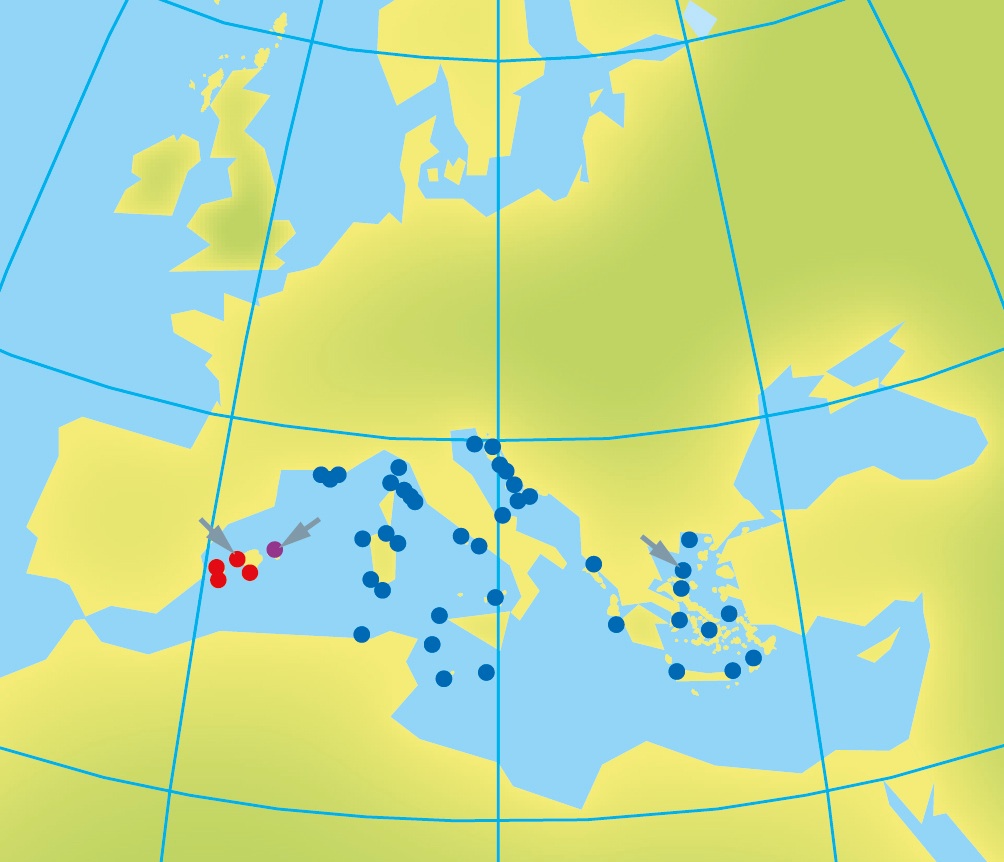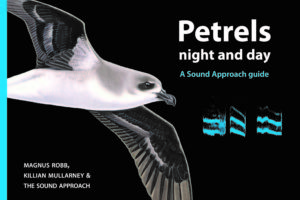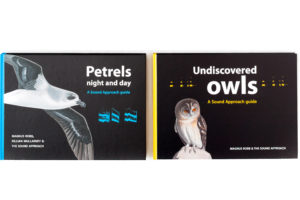
Killian Mullarney
Text by Magnus Robb.
The first time I remember seeing a Balearic Shearwater Puffinus mauretanicus was on 17 September 1997, while watching seabird passage from the old lighthouse on North Ronaldsay, Orkney, Scotland. We had been watching hundreds of Sooty Shearwaters P griseus and a smaller number of Manx Shearwaters P puffinus streaming into the North Sea, when a Balearic passed in good light, heading the other way. What was a bird from the Mediterranean doing, passing the northern end of Scotland, after the breeding season was over? The general wisdom is that if you are a migrating Northern Hemisphere bird, you fly south after breeding, not north. Consulting the literature, I learned that northward migration was quite normal for this species, even if Orkney was a bit too far north for most. The entire population is thought to leave the Mediterranean from May onwards, to take advantage of more plentiful food elsewhere. Formerly, post-breeding Balearics concentrated mainly in the Bay of Biscay, but now they are being seen in increasing numbers off England and further to the north (Wynn & Yésou 2007).
Balearic Shearwaters actually spend so much of their time in the Atlantic Ocean that you might ask, why is an Atlantic bird breeding in the Mediterranean? Indeed, I have often wondered whether Balearic might once have bred in the Atlantic, and what its ancestry might have been. For a long time this was considered a ‘no-brainer’, because Balearic, and also Yelkouan Shearwater P yelkouan of the eastern Mediterranean, were treated as subspecies of Manx Shearwater. Manx was considered a rather cosmopolitan, ‘polytypic species’, which also included subspecies from the Pacific Ocean and around New Zealand (Mathews 1934a, Murphy 1952). All were lumped under Manx because of their similarity in appearance, regardless of reproductive isolation, and whether they could be told apart. But by the late 1980s, mauretanicus and yelkouan were split from Manx (Bourne et al 1988), and collectively came to be referred to as ‘Mediterranean Shearwater’. They turned out to be far less closely related to Manx than previously thought. Manx is no longer considered to have any subspecies, and it may be more closely related to Audubon’s P lherminieri, Barolo P baroli, Boyd’s P boydi and Black-vented Shearwaters P opisthomelas than it is to Balearic and Yelkouan (Heidrich et al 2000).
In taxonomy, as in so many other aspects of life, there’s no rain for ages and then it suddenly pours. By the time we exclaimed ‘Med Shear!’ at the old light on North Ronaldsay, the next wave of taxonomic change had already been set in motion (eg, Sangster et al 1997). Genetic studies show that Balearic and Yelkouan Shearwaters went their separate ways a very long time ago. They have been evolving as two distinct species for a million years or more (Heidrich et al 1998). Some exciting discoveries in paleontology have raised the possibility that, although they are clearly each other’s closest living relatives, they may not be neighbouring branches in the phylogenetic tree.

Hole’s Shearwater Puffinus holei, skull, Fuerteventura, Canary Islands, April 1990 (Miguel McMinn)

Bones of the extinct Hole’s Shearwater Puffinus holei lie strewn over the desert landscape of Fuerteventura, Canary Islands, April 1990 (Miguel McMinn)
In the 1980s, remains of an extinct shearwater were discovered in a cave on Ibiza, dating from the very late Pliocene, a period that ended about 1.8 million years ago. Ibiza Shearwater P nestori was larger than Balearic Shearwater with a 35% more robust bill and 11-15% thicker leg bones. Its larger size suggests that food was plentiful near the Balearic Islands at that time. Ibiza Shearwater was abundant, and with no mammalian predators, the island was a seabirds’ paradise. It had a proportionally long hand, suggesting that its flight was more flapping than that of its modern relatives. This shearwater was probably ancestral to Balearic, which breeds on Ibiza today, and it may be the ancestor of other species as well (Alcover 1989).
Around the same time, Miguel McMinn was part of a team that investigated subfossil deposits in the eastern Canary Islands. The far interior of the Cueva de las Palombas, in the north of Fuerteventura, contained relatively recent deposits. These included bones of the House Mouse Mus musculus, introduced by the guanchos, the first settlers on the Canary Islands, about 2000 years ago. The team also found numerous remains of a previously unknown seabird (McMinn et al 1990). Its bones were especially abundant in recent lava fields, and since then they have also been found in caves on the neighbouring island of Lanzarote. Unfortunately, Lava Shearwater P olsoni, which Miguel described to me as a longer-winged, smaller version of Manx Shearwater, is now extinct. However, it was with us until relatively recently. The youngest known bone has been radiocarbon dated to no earlier than 1050 AD, but its true date is probably later than 1290 AD. Lava Shearwater probably became extinct when Europeans arrived at the start of the 14th century, making it one of only two seabirds known to be lost in Europe during the last millennium (Rando & Alcover 2007).

Ibiza shearwater Puffinus nestori (pink cross)
Lava Shearwater Puffinus olsoni (purple cross)
Hole’s Shearwater Puffinus holei (yellow cross)
Remains of another extinct shearwater from Fuerteventura were found early in 1985 by Jean Hole, while exploring a sand dune complex in the southern end of the island. Hole’s Shearwater P holeae was subsequently described and named by Walker et al (1990), who collected more bones at the same site. Adults and nestlings were found together with egg shells, indicating the former presence of a large breeding colony. One egg shell could be dated as about 25 000 years old, meaning that the colony existed during the Devensian glaciation, the last extremely cold period in northern Europe. Having been to Fuerteventura myself, I imagine the shearwaters breeding under tussocks of dune grass in flat, sandy areas where Houbara Bustards Chlamydotis undulata are currently the main attraction. Remains have also been found among crags on Lanzarote, on the neighbouring islet of Graciosa, and at Figueira Brava in Portugal (Alcover & McMinn 1995). Hole’s was a large shearwater, and some ‘Great Shearwater’ remains collected near Malaga (Tyrberg 1998) need to be re-examined; they may also belong to Hole’s. Walker et al (1990) thought that Hole’s was probably Balearic’s closest relative, as it more closely resembles Balearic in skeletal structure than Manx or Yelkouan Shearwater. Nobody knows quite when it became extinct, but life may have become difficult for this large shearwater when the seas became less nutrient-rich and food became scarcer, as the last Ice Age came to a close.
In recent years, fears have been expressed that Balearic may be the next shearwater to become extinct. A study based on data available in 2002 estimated its time to demise at only 40 years (Oro et al 2004). The latest population estimate is just 2000-2400 breeding pairs (Rodriguez-Molina & McMinn-Grivé 2005). With most breeding in caves on cliff faces, Balearic is not straightforward to census. Miguel and his colleague Ana Rodriguez have spent many a night listening for calls under promising-looking cliffs and around rocky islets. Each year they find one or two previously unknown breeding sites. An even greater part of their time is spent trying to eradicate rats and feral cats from islets where the shearwaters are most numerous. This is an uphill struggle; even national park wardens, who really should know better, have sometimes brought their pets along to these islands.

Balearic Shearwater Puffinus mauretanicus, Carnsore Point, Wexford, Ireland, 15 September 2007 (Killian Mullarney)
Another alleged threat to the survival of Balearic Shearwater is the possibility of hybridisation with Yelkouan Shearwater (Genovart et al 2005). Sharing the Mediterranean between them, the fates of these two species are inevitably entwined. A population of Yelkouan look-alikes was discovered breeding on the Balearic island of Menorca in the 1990s, but when their DNA was sequenced, it was found to contain genes inherited from both species. These ‘Menorcan shearwaters’ P mauretanicus/yelkouan are considered in depth in the final part of this chapter.
Few species have proven to be as problematic to record as Balearic Shearwater. The remaining colonies are difficult to access, and without the considerable help of Miguel and Ana, there would be no recordings in this publication at all. My first attempt to record them, in April 2003, was jinxed by spring storms. I returned to Mallorca with Arnoud in March 2007, only to meet with freshening winds once again. Arnoud made some excellent recordings on our first night, in a tiny cave sheltered from the wind. Then a force nine gale put things on hold for a couple of days, and we had to wait until our very last night before the wind finally eased. When it did, we experienced one of the most memorable nights of our lives.
Not long before our visit, Charlotte Curé, a French PhD student who was also studying shearwater sounds, had arrived unexpectedly at Miguel and Ana’s office. So when Miguel took us out to two small islets just off Mallorca, he dropped us off at three different spots. Charlotte had a smaller islet, nearest to Mallorca, all to herself. Then Miguel dropped me and Arnoud at opposite ends of a larger islet, several hundred metres apart. Arnoud’s stake-out was about halfway up a 30 m high cliff. I helped him to hoist up his gear, and when I saw the uneven ledge Arnoud would have to sleep on, I hoped Miguel would bring me somewhere a bit more comfortable. Close to the far end of the island, there was a natural amphitheatre cut into the cliff. Miguel knew a good many burrows there, and the acoustics seemed very promising. Only the Yellow-legged Gulls Larus michahellis were a problem. At the least movement from me, hundreds would take off silently on a kind of ‘dread’ flight, breaking into a great cacophony a few seconds later.

Breeding habitat of Balearic Shearwater Puffinus mauretanicus, Mallorca, Balearic Islands, 14 March 2007 (Arnoud B van den Berg). During our visit, Charlotte spent the night on the islet you can see part of on the left, Arnoud stayed at the near end of the islet you can see on the right, and Magnus was at its far end, which is out of view.

‘Mediterranean shearwaters’: known breeding distribution.
Recording locations indicated by arrows.
Balearic Shearwater Puffinus mauretanicus (red dots).
Recordings: Mallorca, Balearic Islands.
‘Menorcan shearwater’ Puffinus mauretanicus / yelkouan (purple dot).
Recordings: La Mola, Menorca, Balearic Islands.
Yelkouan Shearwater Puffinus yelkouan (blue dots).
Recordings: Alonissos, northern Sporades, Greece.
As the light faded and the gulls finally settled down, a very good omen drifted across the calm sea. Miguel later told me that he had seen a raft of about 200 shearwaters while heading back to port, so it must have been their calls that I could hear in the distance. Throughout the night, there were periods of activity when a whole company of shearwaters performed in the amphitheatre, and intermissions when they retreated back out to sea. They were at their most vocal around 03:00, by which time I was taking a rest. Balearics were hurtling past only a couple of metres above me. Without getting out of my sleeping bag, I reached for the microphones and put them on a prominent rock nearby. Then I laid back, listened through my headphones and made several recordings. You can hear part of the longest one in CD1-50.

Breeding habitat of Balearic Shearwater Puffinus mauretanicus, Mallorca, Balearic Islands, 14 March 2007 (Arnoud B van den Berg). This was the ‘amphitheatre’ where Magnus recorded CD1-50 and CD1-51.
CD1-50: Balearic Shearwater Puffinus mauretanicus Mallorca, Balearic Islands, 03:04, 14 March 2007. Courtship of non-breeders on a calm night, around the time of egg-laying. Calls of both males and females, mostly in flight, but with some calling from the cliffs. Background: Yellow-legged Gull Larus michahellis. 070314.MR.30414.00
I recall being quite surprised to see 37 minutes on the timer, when I checked to see how long I had been recording. When I listened to the recording later, a sort of deep, walrus-like sound appeared after about 24 minutes. Intermittent and quiet at first, it got louder and more persistent towards the end. Just before 37 minutes, it stopped. This was the first time I ever heard the sound of my own snoring!
The Balearic Shearwater calls in the recording sound very different from those of Manx Shearwater. In Balearic, as well as Yelkouan Shearwater, there is just one exhaled note before each breath note. The exhaled note is always louder, and usually longer than the inhaled one. By contrast, Manx has several exhaled notes, typically three or four but occasionally just two.
Sexing in Balearic Shearwater is usually straightforward, as long as you can distinguish clearly between the exhaled note and the inhaled one. The exhaled note in males has a clear timbre with prominent harmonics, while in females this note has a harsh timbre, showing in sonagrams as a chaotic region. In the quieter, inhaled note, the polarity is reversed: harsh in males and clear in females. The louder, exhaled clear note of males has a higher fundamental frequency than the quieter, inhaled clear note of the female.

Balearic Shearwater Puffinus mauretanicus, juvenile, Carnsore Point, Wexford, Ireland, 15 September 2007 (Killian Mullarney)
In CD1-51, you can hear both sexes engaged in ground to air courtship. Not far from the microphones, two male burrow-owners were calling from the ground, trying to attract a female. After a while, a passing female in flight took note, and began calling and circling nearby. From 0:08 in CD1-51, you can hear the males trying to call her down, one overlapping the other. Then the female comes hurtling past, calling as she passes a second time from 0:27, then again from 0:59 and 1:29. After I had pressed the stop button, one of the males took off, calling, then whirled around the amphitheatre with the female. They soon disappeared, perhaps to continue their courtship out at sea.
CD1-51: Balearic Shearwater Puffinus mauretanicus Mallorca, Balearic Islands, 21:10, 13 March 2007. Two males are attempting to attract passing females to their burrows. A female takes interest and circles in flight nearby. Background: Scopoli’s Shearwater Calonectris diomedea and Yellow-legged Gull Larus michahellis. 070313.MR.211044.00
Four nights earlier, there was much less activity. The situation could hardly have been more different. On that occasion, we all occupied the same stake-outs. On her islet, Charlotte found only a single calling Balearic Shearwater in a burrow, but she was delighted because it was her first. My own stake-out, the amphitheatre, was quiet. Only a single female called briefly in flight, and one or two males called from their crevices.
Arnoud, meanwhile, had a very productive night. Sitting on his uneven ledge, he was able to see a succession of shearwaters arriving in silence, making a bee-line for a tiny cave in the cliff just above him. When he realised where they were going, he climbed up and put his microphones in the entrance to the cave. Pairs were occupying crevices around the perimeter, and for more than two hours, Arnoud recorded the calls that were being exchanged between them.

Balearic Shearwater Puffinus mauretanicus, Mallorca, Balearic Islands, 13 March 2007 (Arnoud B van den Berg). One of the individuals visiting the small cave where Arnoud recorded CD1-52.
CD1-52: Balearic Shearwater Puffinus mauretanicus Mallorca, Balearic Islands, 22:04, 9 March 2007. Burrow defence behaviour of males, during the pre-laying period. A fight breaks out at 0:17, and a female also puts in an appearance at 0:26. 07.005.AB.00035.00
Most of the birds attending the colony that first night would have been breeders. The weather was a bit rough, making foraging conditions difficult, and Miguel thought that most non-breeders would stay out at sea to continue the search for food. Burrow defence is so important in this pre-laying period, however, that breeders already possessing a burrow head straight for the colony, in case any non-breeders turn up after all. Judging from the noise level in Arnoud’s cave, one or two probably did (CD1-52).
In shearwater colonies, non-breeders are typically young strangers looking for any opportunity to establish a future breeding burrow. Established, neighbouring breeders have no need to compete with each other, but all must defend their burrows against strangers. So being able to recognise unfamiliar calls is a great advantage. It is not known whether male Balearic Shearwaters can do this, but Mackin (2005) proved that Audubon’s Shearwaters can in a series of playback experiments. He explained it in terms of the ‘real enemy’ effect. Strangers, not neighbours, are the ‘real enemies’ and their calls provoke a vigorous response. In CD1-52, all but one of the callers are males. Emotions are running high, and a fight breaks out at 0:17. When the pitch of the exhaled notes becomes unstable and the tone becomes harsher, you can tell there is physical contact. Try singing and wrestling at the same time and you’ll see what I mean. A female joins in the fight too; she can be heard from 0:26 to 0:39.
Despite sounding so close, the shearwaters in CD1-52 were all out of sight, much to the frustration of Arnoud, who had been hoping to take some photos. The image shown was shot at the entrance of the same cave, four nights later, when Arnoud knew exactly where the shearwaters would land. At one point, he heard a flapping of wings, followed by an almighty din, as a hapless shearwater collided with his parabolic microphone. Fortunately for his hearing, he was not using the dish at the time. The shock would have been brief, because as the microphone was hit by the shearwater, one of its cables broke. The bird soon took off, but the microphone was out of action for a week.


